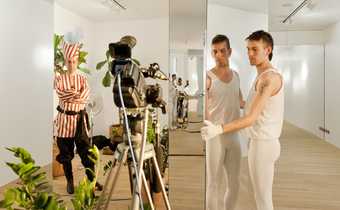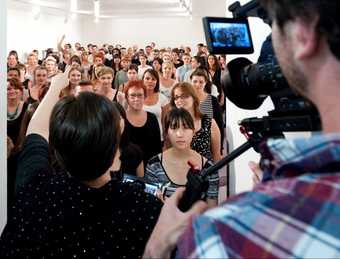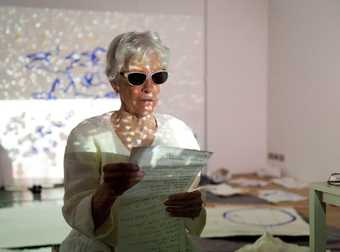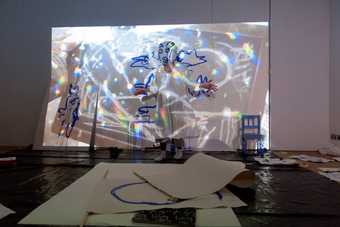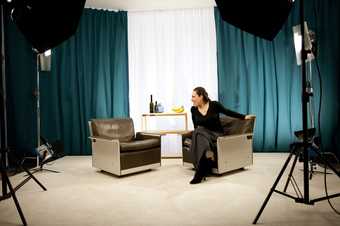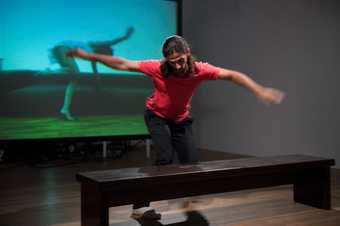The original idea was simple: to give access to an artist working and experimenting in a studio in real-time. In Performance Room each artist is invited to spend a week rehearsing at Tate Modern, which culminates in a unique presentation in front of a camera. The performance is streamed live on YouTube, enabling viewers worldwide to watch it at exactly the same moment across time zones.
If you think of the black-and-white footage of Bruce Nauman walking in his studio, recording his movements with a camera set up in a fixed position, you get a sense of how Performance Room operates: one room, one camera, and no post-production.
The room itself is a neutral rectangular nine-by-five-metre space with white walls, no windows, a wooden floor and track lighting. It is converted into an artist’s studio for a week and transformed each time by the person who inhabits it. For his performance, Pablo Bronstein created a baroque trompe l’oeil stage set which exaggerated the perspective of the space with movable mirrored columns. He explains:
The most challenging aspect of the room, and one which differed from both the making of a film and the performance on a stage, was the absence of a backstage or wings in which to hide or prepare, enter or exit. Inside the room you were always ‘in’ the piece, whether you liked it or not. I encouraged this exposedness further by lining the back wall with mirrors, so there was never a fixed area where you might be off-camera to relax. No dark corners.
While the work takes place at Tate Modern, its primary site is online. The location of the room is irrelevant, as the audience is invited to enter a digital space, rather than a gallery in the museum. Online viewers are the sole audience of the series.
Each artist experiences the relationship with this physically absent and unknown audience differently. Joan Jonas, a pioneer in the history of video and performance art, considers this the most interesting part of the project. ‘This is why I spoke directly to the camera close up of course,’ says Jonas. ‘One has done this before, but the feeling in this case was that one was really directly addressing an audience, rather than just speaking to the camera alone in the studio.’
Emily Roysdon invited more than 100 volunteers who self-identified as queer and/or feminist to fill and occupy the room. She described the relationship with the audience as ‘speculative and hopeful, simultaneously intimate and abstract’. This relationship was fundamentally a hostile one for Bronstein. ‘I felt it thus because of the invisible and silent presence of the viewer through the camera lens,’ he says. ‘The live audience is protected behind their computer screens, so they are free to react with impunity - they will not be held to account by other audience members if they yawn, walk out (switch off), or make abusive comments.’ This feeling was accentuated by the bright light and the mirrored environment, ‘meaning that every mistake and movement was constantly on view’, which, for the artist, contrasted ‘with people all over the world in their bedrooms’ in what he imagined ‘to be darkness and anonymity’.
So what does the liveness of the situation add to the project? For some artists it creates a more direct relationship between the performer and the audience. ‘There is an enormous difference between filming Performance Room and making a film that you know will face its audience at a later stage,’ observes Bronstein. ‘Here, I knew I was being watched, the way one is watched on stage, in that you feel it’s ‘now or never’ and you cannot pull out or stop halfway through.’
Everything happens on-site, broadcast at the time of occurrence, without editing. This process is familiar to the London-based artist Cally Spooner, who will launch the 2014 series on 27 February. Her most recent film, Collapsing In Parts 2012, was shot to camera in a single take, produced with a live team, rather than with an editor afterwards. In the same spirit, Spooner will create in her Performance Room a trailer for a forthcoming film, as ‘an act of live editing’. She is already thinking about how she will need to adapt the space. ‘My commission is going to have a lot of music in it – drumming and singing, possibly keyboards,’ she explains, “so there’s going to be a lot of pre-production to do, in terms of getting the room ready so that all these elements can work and sound right. I need to turn it into a black-box TV studio.’
For the choreographers and dancers Selma and Sofiane Ouissi, the format of Performance Room corresponds perfectly to the working conditions they have been facing for many years. With Selma living in Paris and Sofiane in Tunis, the internet is vital for them to collaborate and produce new works. They addressed this situation in Here(s) 2011–12, in which they perform live, via Skype, while in different cities. On 18 September they will perform a new work that confronts the intimacy of their daily lives with the public platform of the internet. As with their earlier work which relied on live video feeds, the choreographers intend to explore further the impression ‘of being here while at the same time being there, being one while being multiple’.
Over the past two years, Performance Room has experimented with the presentation of art and our experience of it by testing new ways of making, filming and sharing it. While the internet as a site for artistic production remains underexplored, the artists’ responses to the project indicate that there is much potential in the development of online exhibition and curatorial space.

